boot Seat Alhambra 2011 Owner's Manual
[x] Cancel search | Manufacturer: SEAT, Model Year: 2011, Model line: Alhambra, Model: Seat Alhambra 2011Pages: 385, PDF Size: 7.92 MB
Page 17 of 385
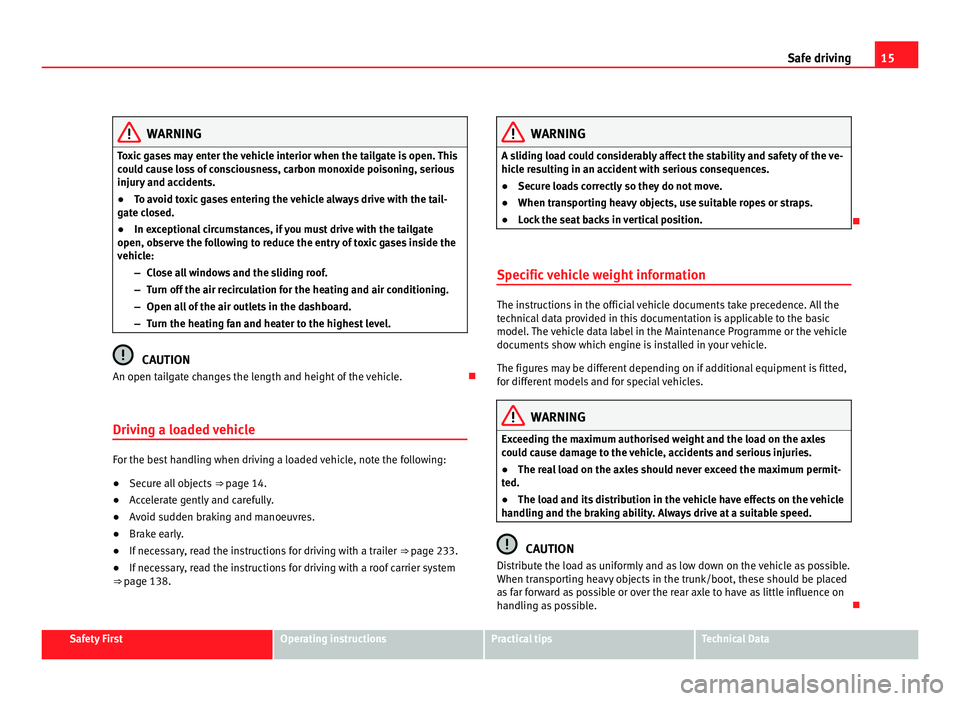
15
Safe driving WARNING
Toxic gases may enter the vehicle interior when the tailgate is open. This
cou l
d cause loss of consciousness, carbon monoxide poisoning, serious
injury and accidents.
● To avoid toxic gases entering the vehicle always drive with the tail-
gate c
losed.
● In exceptional circumstances, if you must drive with the tailgate
open, obser
ve the following to reduce the entry of toxic gases inside the
vehicle:
–Close all windows and the sliding roof.
– Turn off the air recirculation for the heating and air conditioning.
– Open all of the air outlets in the dashboard.
– Turn the heating fan and heater to the highest level. CAUTION
An open tailgate changes the length and height of the vehicle.
Driving a loaded vehicle For the best handling when driving a loaded vehicle, note the following:
●
Secure all objects
⇒ pag
e 14.
● A
ccelerate gently and carefully.
● Avoid sudden braking and manoeuvres.
● Brake early.
● If necessary, read the instructions for driving with a trailer
⇒ page 233.
● If
necessary, read the instructions for driving with a roof carrier system
⇒ page 138. WARNING
A sliding load could considerably affect the stability and safety of the ve-
hicl e r
esulting in an accident with serious consequences.
● Secure loads correctly so they do not move.
● When transporting heavy objects, use suitable ropes or straps.
● Lock the seat backs in vertical position.
Specific vehicle weight information The instructions in the official vehicle documents take precedence. All the
tec
hnic
al data provided in this documentation is applicable to the basic
model. The vehicle data label in the Maintenance Programme or the vehicle
documents show which engine is installed in your vehicle.
The figures may be different depending on if additional equipment is fitted,
for different models and for special vehicles. WARNING
Exceeding the maximum authorised weight and the load on the axles
cou l
d cause damage to the vehicle, accidents and serious injuries.
● The real load on the axles should never exceed the maximum permit-
ted.
● The loa
d and its distribution in the vehicle have effects on the vehicle
handling and the br
aking ability. Always drive at a suitable speed. CAUTION
Distribute the load as uniformly and as low down on the vehicle as possible.
When tran s
porting heavy objects in the trunk/boot, these should be placed
as far forward as possible or over the rear axle to have as little influence on
handling as possible. Safety First Operating instructions Practical tips Technical Data
Page 89 of 385
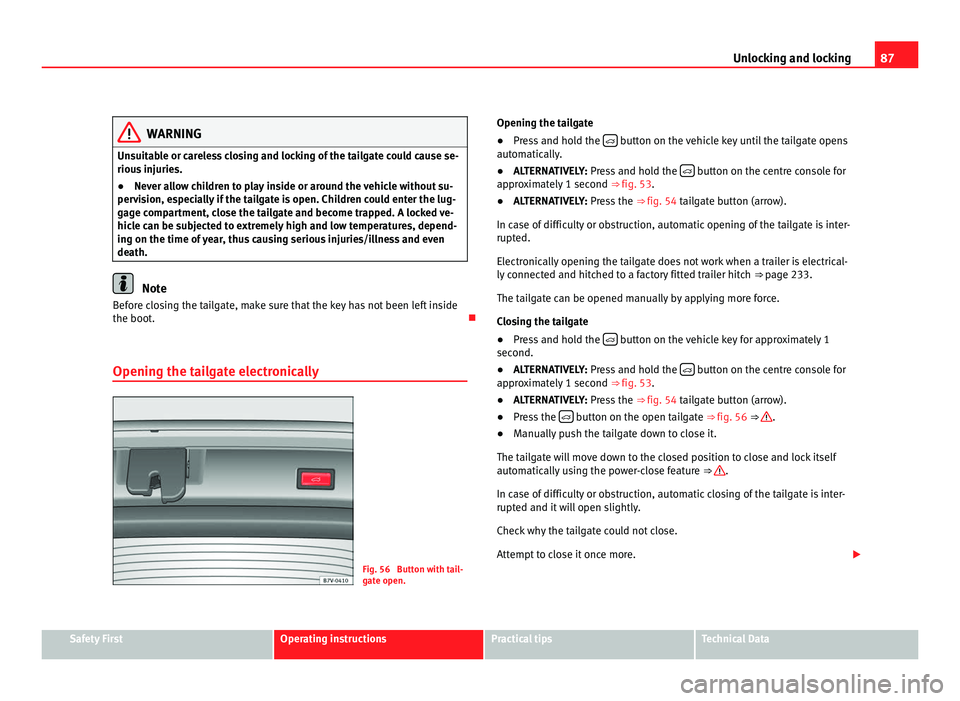
87
Unlocking and locking WARNING
Unsuitable or careless closing and locking of the tailgate could cause se-
rious injurie
s.
● Never allow children to play inside or around the vehicle without su-
pervi
sion, especially if the tailgate is open. Children could enter the lug-
gage compartment, close the tailgate and become trapped. A locked ve-
hicle can be subjected to extremely high and low temperatures, depend-
ing on the time of year, thus causing serious injuries/illness and even
death. Note
Before closing the tailgate, make sure that the key has not been left inside
the boot.
Openin g the t
ailgate electronically Fig. 56 Button with tail-
gat
e open. Openin
g the tailgate
● Press and hold the button on the vehicle key until the tailgate opens
autom atic
ally.
● ALTERNATIVELY: Pres
s and hold the button on the centre console for
appr o
ximately 1 second ⇒ fig. 53.
● ALTERNATIVELY: Pres
s the ⇒ fig. 54 tailgate button (arrow).
In case of difficulty or obstruction, automatic opening of the tailgate is inter-
rupted.
Electronically opening the tailgate does not work when a trailer is electrical-
ly connected and hitched to a factory fitted trailer hitch ⇒ page 233.
The tailgate can be opened manually by applying more force.
Closing the tailgate
● Press and hold the button on the vehicle key for approximately 1
second.
● ALTERNA
TIVELY: Pres
s and hold the button on the centre console for
appr o
ximately 1 second ⇒ fig. 53.
● ALTERNATIVELY: Pres
s the ⇒ fig. 54 tailgate button (arrow).
● Press the button on the open tailgate ⇒
fig. 56
⇒ .
● Manually push the tailgate down to close it.
The tai l
gate will move down to the closed position to close and lock itself
automatically using the power-close feature ⇒ .
In ca se of
difficulty or obstruction, automatic closing of the tailgate is inter-
rupted and it will open slightly.
Check why the tailgate could not close.
Attempt to close it once more. Safety First Operating instructions Practical tips Technical Data
Page 90 of 385
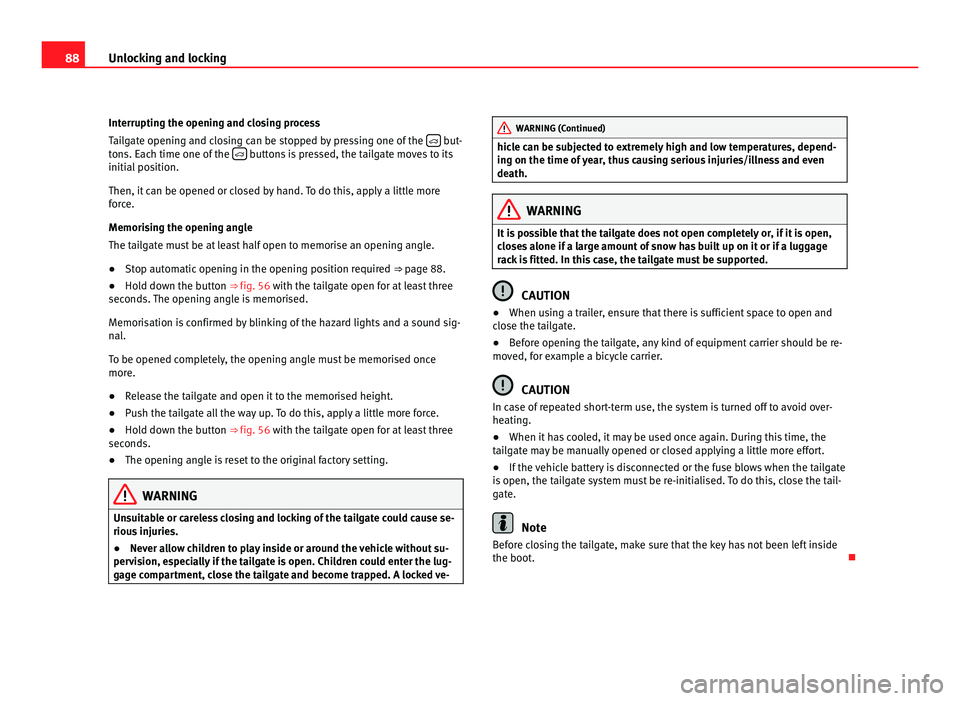
88
Unlocking and locking
Interrupting the opening and closing process
Tai l
gate opening and closing can be stopped by pressing one of the but-
ton s. E
ach time one of the buttons is pressed, the tailgate moves to its
initial po
sition.
Then, it can be opened or closed by hand. To do this, apply a little more
force.
Memorising the opening angle
The tailgate must be at least half open to memorise an opening angle.
● Stop automatic opening in the opening position required ⇒ pag
e 88.
● Hold down the button ⇒ fig. 56 w
ith the tailgate open for at least three
seconds. The opening angle is memorised.
Memorisation is confirmed by blinking of the hazard lights and a sound sig-
nal.
To be opened completely, the opening angle must be memorised once
more.
● Release the tailgate and open it to the memorised height.
● Push the tailgate all the way up. To do this, apply a little more force.
● Hold down the button ⇒ fig. 56 w
ith the tailgate open for at least three
seconds.
● The opening angle is reset to the original factory setting. WARNING
Unsuitable or careless closing and locking of the tailgate could cause se-
rious injurie
s.
● Never allow children to play inside or around the vehicle without su-
pervi
sion, especially if the tailgate is open. Children could enter the lug-
gage compartment, close the tailgate and become trapped. A locked ve- WARNING (Continued)
hicle can be subjected to extremely high and low temperatures, depend-
in g on the time of
year, thus causing serious injuries/illness and even
death. WARNING
It is possible that the tailgate does not open completely or, if it is open,
clo se
s alone if a large amount of snow has built up on it or if a luggage
rack is fitted. In this case, the tailgate must be supported. CAUTION
● When using a trailer, ensure that there is sufficient space to open and
c lo
se the tailgate.
● Before opening the tailgate, any kind of equipment carrier should be re-
moved, f
or example a bicycle carrier. CAUTION
In case of repeated short-term use, the system is turned off to avoid over-
heatin g.
● When it
has cooled, it may be used once again. During this time, the
tail
gate may be manually opened or closed applying a little more effort.
● If the vehicle battery is disconnected or the fuse blows when the tailgate
is open, the t
ailgate system must be re-initialised. To do this, close the tail-
gate. Note
Before closing the tailgate, make sure that the key has not been left inside
the boot.
Page 200 of 385
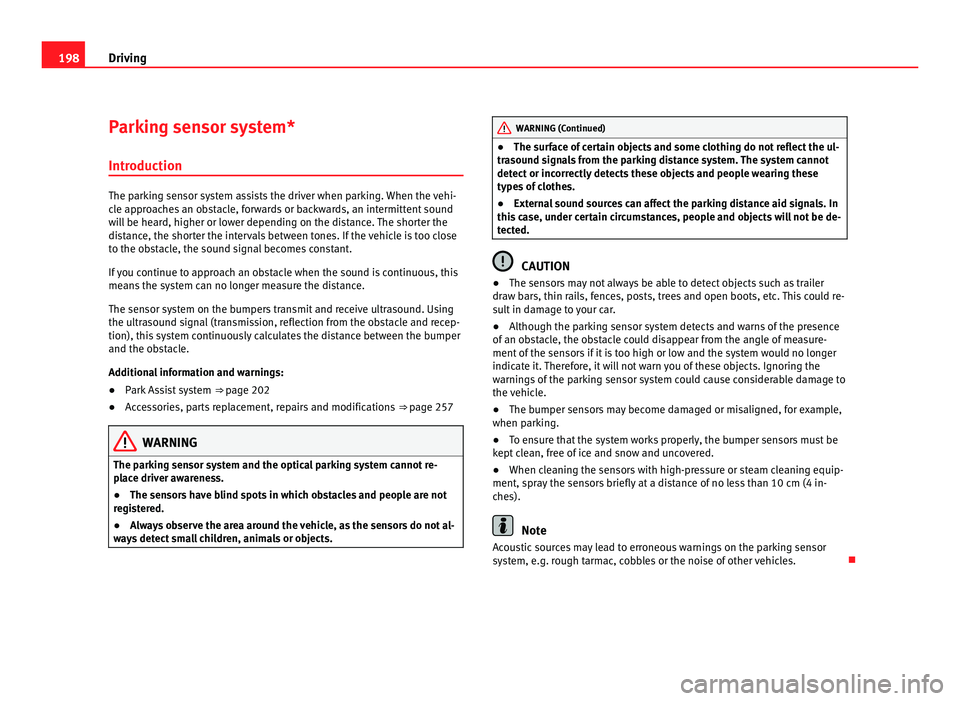
198
Driving
Parking sensor system*
Introduction The parking sensor system assists the driver when parking. When the vehi-
cl
e ap
proaches an obstacle, forwards or backwards, an intermittent sound
will be heard, higher or lower depending on the distance. The shorter the
distance, the shorter the intervals between tones. If the vehicle is too close
to the obstacle, the sound signal becomes constant.
If you continue to approach an obstacle when the sound is continuous, this
means the system can no longer measure the distance.
The sensor system on the bumpers transmit and receive ultrasound. Using
the ultrasound signal (transmission, reflection from the obstacle and recep-
tion), this system continuously calculates the distance between the bumper
and the obstacle.
Additional information and warnings:
● Park Assist system ⇒ page 202
● A
ccessories, parts replacement, repairs and modifications ⇒ page 257WARNING
The parking sensor system and the optical parking system cannot re-
pl ac
e driver awareness.
● The sensors have blind spots in which obstacles and people are not
regi
stered.
● Always observe the area around the vehicle, as the sensors do not al-
way
s detect small children, animals or objects. WARNING (Continued)
● The s urface of certain objects and some clothing do not reflect the ul-
tr a
sound signals from the parking distance system. The system cannot
detect or incorrectly detects these objects and people wearing these
types of clothes.
● External sound sources can affect the parking distance aid signals. In
this c
ase, under certain circumstances, people and objects will not be de-
tected. CAUTION
● The sensors may not always be able to detect objects such as trailer
dr a
w bars, thin rails, fences, posts, trees and open boots, etc. This could re-
sult in damage to your car.
● Although the parking sensor system detects and warns of the presence
of an ob
stacle, the obstacle could disappear from the angle of measure-
ment of the sensors if it is too high or low and the system would no longer
indicate it. Therefore, it will not warn you of these objects. Ignoring the
warnings of the parking sensor system could cause considerable damage to
the vehicle.
● The bumper sensors may become damaged or misaligned, for example,
when parkin
g.
● To ensure that the system works properly, the bumper sensors must be
kept c
lean, free of ice and snow and uncovered.
● When cleaning the sensors with high-pressure or steam cleaning equip-
ment, spra
y the sensors briefly at a distance of no less than 10 cm (4 in-
ches). Note
Acoustic sources may lead to erroneous warnings on the parking sensor
sys t
em, e.g. rough tarmac, cobbles or the noise of other vehicles.
Page 210 of 385
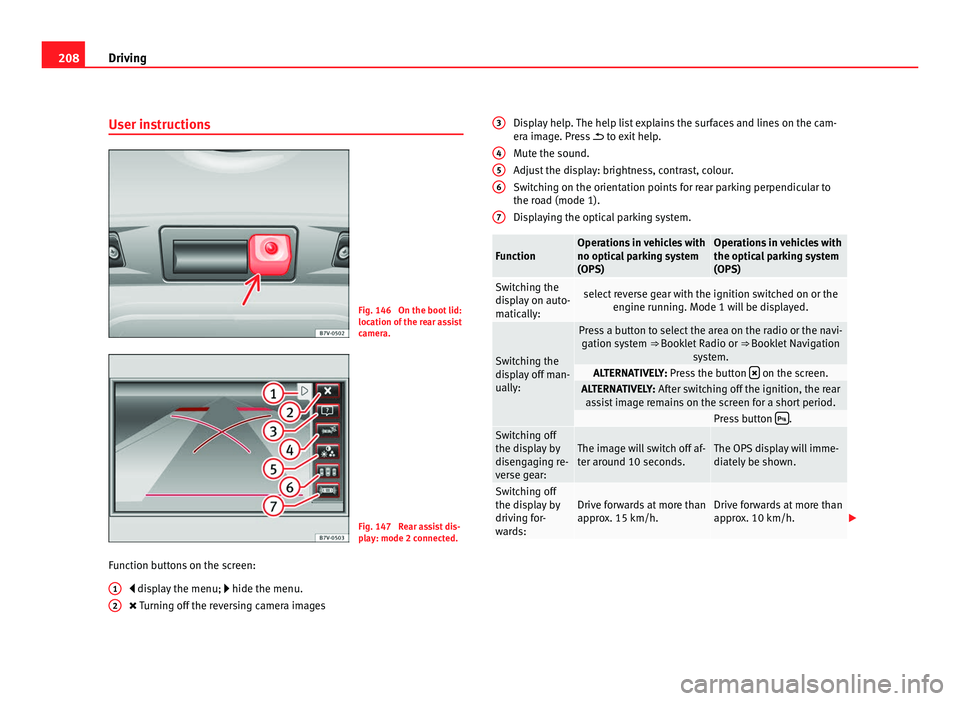
208
Driving
User instructions Fig. 146 On the boot lid:
location of
the r
ear assist
camera. Fig. 147 Rear assist dis-
pl
a
y: mode 2 connected.
Function buttons on the screen: disp
lay the menu; hide the menu.
Turning off the reversing camera images
1 2 Display help. The help list explains the surfaces and lines on the cam-
era im
ag
e. Press to exit help.
Mute the sound.
Adjust the display: brightness, contrast, colour.
Switching on the orientation points for rear parking perpendicular to
the road (mode 1).
Displaying the optical parking system. Function Operations in vehicles with
no optica
l
parking system
(OPS) Operations in vehicles with
the optica
l
parking system
(OPS) Switching the
dis
p
lay on auto-
matically: select reverse gear with the ignition switched on or the
engine ru nnin
g. Mode 1 will be displayed. Switching the
dis
p
lay off man-
ually: Press a button to select the area on the radio or the navi-
gation sy s
tem ⇒ Booklet Radio or ⇒ Booklet Navigation
system. ALTERNATIVELY: Pre
s
s the button on the screen.
ALTERNATIVELY: Aft
er sw
itching off the ignition, the rear
assist image remains on the screen for a short period. Press button
.
Switching off
the dis
p
lay by
disengaging re-
verse gear: The image will switch off af-
ter ar
ou
nd 10 seconds. The OPS display will imme-
diat
ely
be shown. Switching off
the dis
p
lay by
driving for-
wards: Drive forwards at more than
appr
o
x. 15 km/h. Drive forwards at more than
appr
o
x. 10 km/h. 3
4
5
6
7
Page 316 of 385
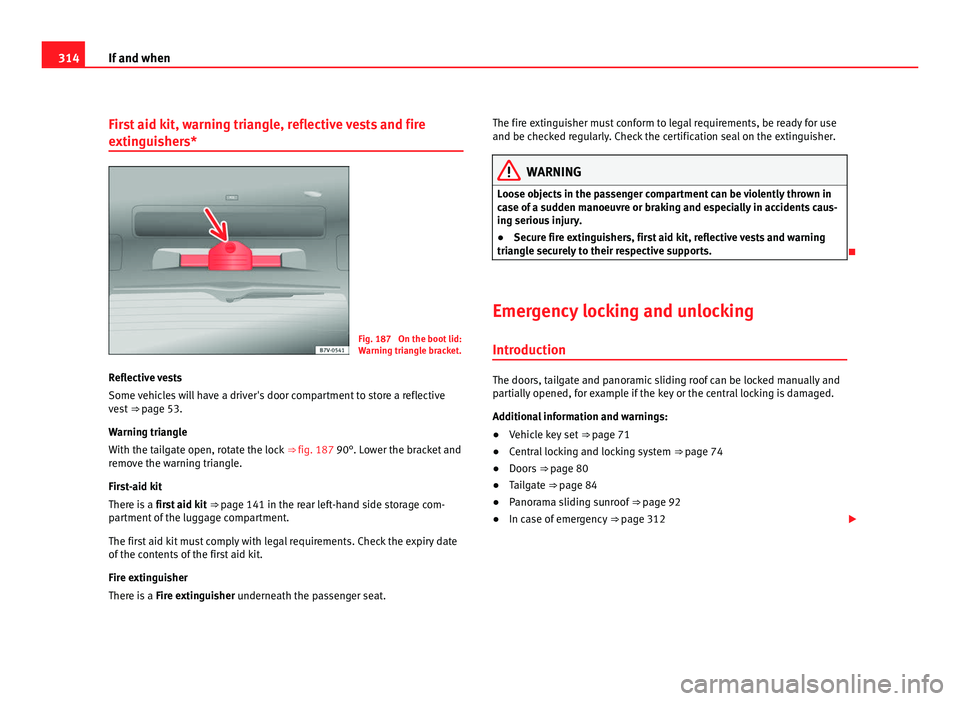
314
If and when
First aid kit, warning triangle, reflective vests and fire
extingui
shers* Fig. 187 On the boot lid:
Warnin
g tri
angle bracket.
Reflective vests
Some vehic
les will have a driver's door compartment to store a reflective
vest ⇒ page 53.
Warning triangle
With the tailgate open, rotate the lock ⇒ fig. 187 90°. Lower the bracket and
remove the warning triangle.
First-aid kit
There is a first aid kit ⇒ page 141 in the rear left-hand side storage com-
partment of the luggage compartment.
The first aid kit must comply with legal requirements. Check the expiry date
of the contents of the first aid kit.
Fire extinguisher
There is a Fire extinguisher underneath the passenger seat. The fire extinguisher must conform to legal requirements, be ready for use
and be check
ed regularly. Check the certification seal on the extinguisher. WARNING
Loose objects in the passenger compartment can be violently thrown in
ca se of
a sudden manoeuvre or braking and especially in accidents caus-
ing serious injury.
● Secure fire extinguishers, first aid kit, reflective vests and warning
triangl
e securely to their respective supports.
Emergency locking and unlocking Introduction The doors, tailgate and panoramic sliding roof can be locked manually and
par
ti
ally opened, for example if the key or the central locking is damaged.
Additional information and warnings:
● Vehicle key set ⇒ pag
e 71
● Central locking and locking system ⇒ pag
e 74
● Doors ⇒ page 80
● T
ailgate ⇒ pag
e 84
● Panorama sliding sunroof ⇒ pag
e 92
● In case of emergency ⇒ pag
e 312
Page 334 of 385
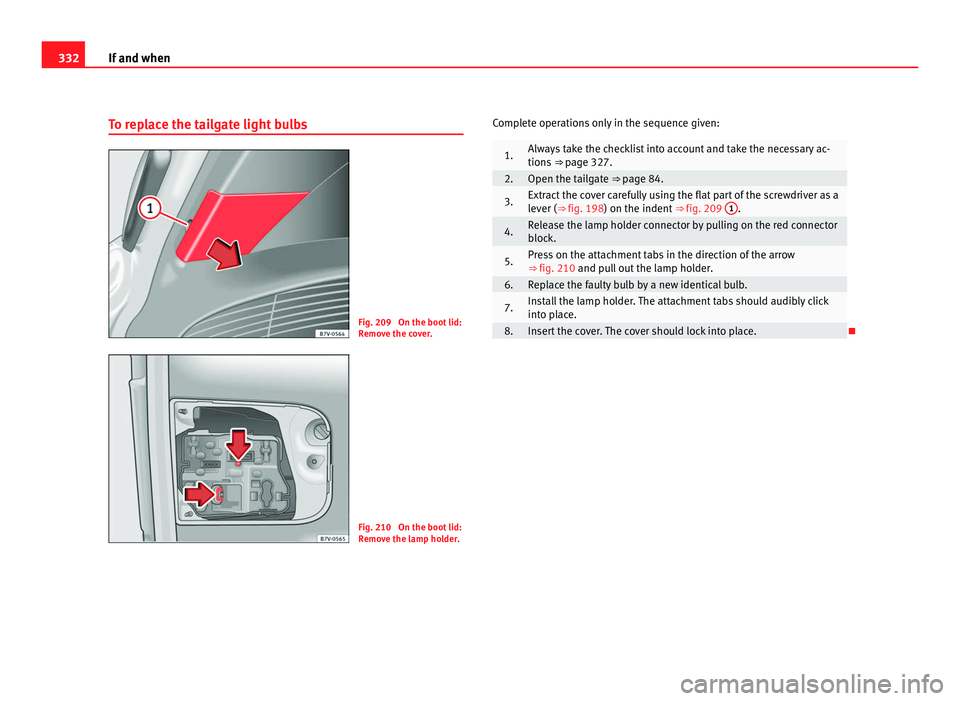
332
If and when
To replace the tailgate light bulbs Fig. 209 On the boot lid:
Remo
v
e the cover. Fig. 210 On the boot lid:
Remo
v
e the lamp holder. Complete operations only in the sequence given: 1. Always take the checklist into account and take the necessary ac-
tions
⇒
page 327. 2. Open the tailgate ⇒ pag
e 84. 3. Extract the cover carefully using the flat part of the screwdriver as a
lev
er (
⇒ fig. 198) on the indent ⇒ fig. 209 1 .
4. Release the lamp holder connector by pulling on the red connector
bloc
k. 5. Press on the attachment tabs in the direction of the arrow
⇒ fig. 210 and pu
l
l out the lamp holder. 6. Replace the faulty bulb by a new identical bulb.
7. Install the lamp holder. The attachment tabs should audibly click
into p
l
ace. 8. Insert the cover. The cover should lock into place.